The Cost of Eye Disorders
How big is the price tag for vision-related issues in the U.S.?
By Amy Spiezio

COSTS BY PAYER BY AGE GROUP
The price tag for vision disorders is getting larger with every passing year. According to a recently released report commissioned by Prevent Blindness America (PBA), vision-related disorders are costing patients, insurance companies, and the U.S. government more than ever before.
And, according to the new report completed by John Wittenborn and David Rein of the independent research organization NORC at the University of Chicago, “Cost of Vision Problems: The Economic Burden of Vision Loss and Eye Disorders in the United States,” the financial burden will continue to grow as a result of increasing healthcare costs and an aging U.S. population.
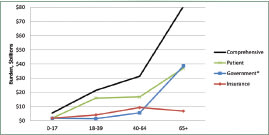
*Government total includes transfer payment costs that are not included in Comprehensive
Breaking down vision disorder cost by age and payer
Vision-related issues are among the costliest health problems to the U.S. economy, far greater than indicated in earlier reports. And, at $139 billion per year (based on the 2011 U.S. population and in 2013 dollars), are more costly than three of the top seven major chronic diseases in the nation today, representatives from PBA note.
BREAKING DOWN THE NUMBERS
The figure cited in this year’s report is significantly—even startlingly—different from the previous figures on the subject in a report released in 2007 by PBA, “The Economic Impact of Vision Problems, The Toll of Major Adult Eye Disorders, Visual Impairment and Blindness on the U.S. Economy.” Then, the cost of vision disorders was estimated to be $51.4 billion.
So why has the number more than doubled? A significant combination of factors are cited as contributing to the growth, according to report presenters at PBA’s “Focus on Eye Health National Summit” that took place at the Washington Marriott at Metro Center in Washington, D.C., this summer.
PER-PERSON ANNUAL MEDICAL COSTS BY DISORDER
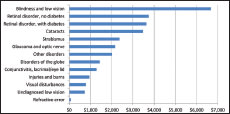
Breaking down the cost of vision disorders from many perspectives. All charts in this article are from “The Economic Burden of Vision Loss and Eye Disorders in the United States” by John Wittenborn and David Rein, NORC, University of Chicago
INDIRECT COSTS BY COST CATEGORY (IN $ MILLIONS)

DIRECT COSTS BY COST CATEGORY (IN $ MILLIONS)

ECONOMIC BURDEN BY STATE
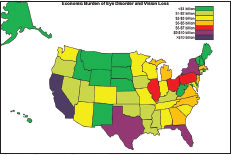
ECONOMIC BURDEN RESULTS (IN $ MILLIONS)
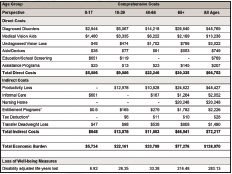
*Transfer payment costs are not included in total
DIRECT AND INDIRECT COSTS BY AGE GROUP
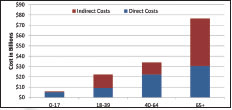
*Transfer payment costs are not included in total costs
MEDICAL COSTS (IN $ BILLIONS) BY DISORDER GROUP
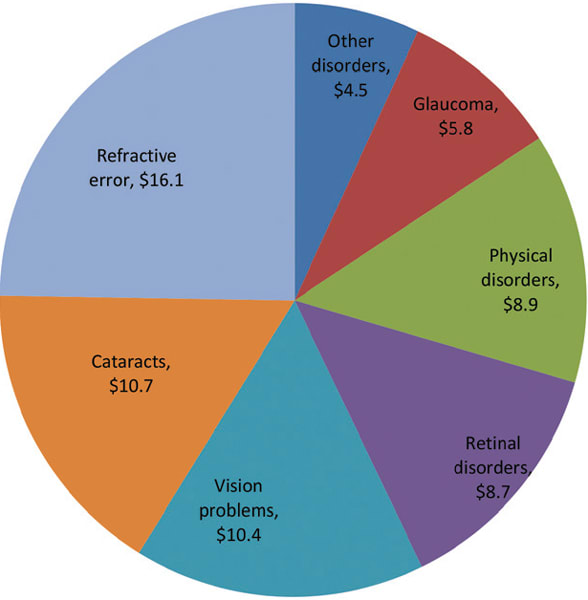
A GROWING PROBLEM?
The study’s co-author, Wittenborn notes that the latest edition is “an update to the landmark 2007 PBA report and provides a much more comprehensive view of the economic challenges associated with vision problems.”
Primary among these new considerations is an expansion of the parameters included in the review. “In addition to a revised methodology, the new report includes cost data across the age spectrum (including children for the first time), and considers all disorders related to the eye,” Wittenborn notes.
While the new report follows the methodology of the previous report for estimating productivity losses, long-term care costs, and federal program cost, it’s also expanded on the model with additional considerations: skilled-nursing facility placement, non-medical aids, and the costs of programs focused on children, including special education and school screening, he notes.
Other new data from the 2013 Economic Burden of Vision Loss and Eye Disorders Report include the following:
■ A breakdown of estimated costs of eye disorders and vision loss from the perspective of three payers: government ($47.4 billion), private insurance ($20.8 billion in direct medical costs and $1.3 billion for long-term care), and patients and their families ($71.6 billion)
■ An economic burden breakdown of vision-related disease presented by state and age
■ Estimates of costs associated with vision loss on disability and quality of life
MOVING FORWARD
With this new data in hand, the eye health community has a greater understanding of the impact of vision impairment, as well as hard numbers to use as a lever to improve eye health in the future.“We feel that we now have a true estimate of the current and growing costs of eye disease in this country. Armed with that information, we can address the need for increased prevention, research, and healthcare options,” says Hugh R. Parry, president and CEO of Prevent Blindness America.
He adds that the cost isn’t just to insurance companies and the government. “It is important that people understand that eye disease is among the most expensive conditions in our country, with more than half the cost currently being assumed by aging patients and their families.” EB



